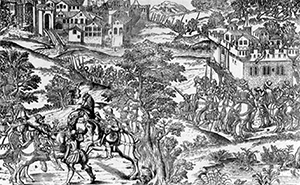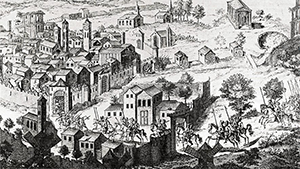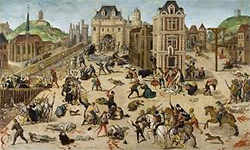The Edict of Nantes
The Edict of Nantes was a royal pronouncement of religious freedom that, more than any other development, helped end the Wars of Religion. King Henry IV issued the Edict in 1598. Religious warfare between Catholics and Huguenots had riven the French cities and countryside for 36 years by that time. The number of dead, injured, and missing as a result of the many battles that took place during that time has been estimated to be in the millions. The French King Henry II had signed the Peace of Cateau-Cambrésis with German princes in 1559. Those princes were Protestants. At the same time, Henry was a devout Catholic and targeted Protestants in his own country. Just after his ascension, he installed the Chambre Ardente in the Parlement of Paris, in order to try heretics. In the last year of his reign, he issued the Edict of Écouen, to further religious prosecution. He particularly targeted the Huguenots, with the 1551 Edict of Châteaubriant, which included a ban on unapproved books. Thus, the doctrine of religious intolerance had been set. Following Henry on the throne were three of his sons, all of whom leaned on their mother, Catherine de Medici, to manage affairs. Francis, Charles, and Henry all went through varying levels of religious strife as they tried to keep the country together. 
First up was Francis II, who ascended the throne when he was 15. One thing that the young king really liked doing was hunting. He liked taking his new wife, Mary, Queen of Scots, with him, and so they went on several hunts together. While they were thus occupied, Catherine and the Guise family were running the government, with François Guise running the army and Cardinal Charles Guise taking care of financial and political matters. This didn't sit well with a number of people in France, particularly the Huguenots, who had been victims of persecution before. Francis had chosen to maintain those policies, and the Huguenots had had enough. On March 17, 1560, a large group of people, Huguenots among them, stormed the royal cháteau at Amboise; royal security had no trouble stopping the attack, and the king later ordered the leaders of the attack executed. Rather than keep the peace, these executions served to inflame the populace, and riots proliferated in various cities, notably Lyon and Provence. King Francis sent royal troops to disperse the rioters. Francis was on the throne for 18 months before he died, on Dec. 5, 1560. At that moment, Charles became King of France; he was 10. A 1561 religious conference known as the Colloquy of Poissy came to no real reconciliation. Catherine was a Catholic but wanted to keep the peace more than prosecute a religious vendetta. She had the government issue the Edict of Saint-Germain, in January 1562, granting some demands made by Huguenots. The response from the powerful Catholic Guise family was to order a wholesale killing of Huguenots in Wassy on March 1. This came to be known as the Massacre of Wassy. Unsurprisingly, Huguenots took up arms against the government in response. 
A truce in March 1563 held for four years. Religious violence flared up again in 1567. A number of Huguenots tried to capture the king and members of his family at Meaux. This plot, too, was foiled. Angry Huguenots in Nîmes killed Catholics on the Christian holiday of Michaelmas, an incident that came to be known as Michelade. More battles followed, and the king in 1568 declared another peace. Catholic militants unhappy with the terms of that peace resumed the fighting, and the war dragged on, this time involving forces from England, Navarre, Spain, and Tuscany. Charles IX married in 1570, to Elisabeth of Austria; they had a daughter, Marie Elisabeth of Valois. In that same year came the Peace of Saint-Germain-en-Laye, after which Charles increasingly took advice from Admiral Gaspar de Coligny, a Huguenot leader. 
In an attempt to keep the peace, the Huguenot Henry of Navarre married the Catholic Margaret of Valois, sister of the king, on Aug. 18, 1572. The marriage took place in Paris, a Catholic stronghold. Thousands of Protestants traveled to the capital for the wedding. A week after the wedding, in August 1572, the Duke of Guise, a leader of the Catholic war effort, killed Coligny, a Huguenot leader. The violence that followed last five days. Catholics by the thousands targeted Huguenots by the thousands, in what came to be called the St. Bartholomew's Day massacre (right). Estimates of the dead range widely, from a few thousand to tens of thousands. Huguenots responded again with warfare, and Catholics joined in the fray. Charles in 1573 issued the Edict of Boulogne, which granted religious freedom and amnesty to the Huguenots living in France. This angered Catholics, and the violence continued off and on for months. Charles died in 1574, and his younger brother Henry took the throne. Henry tried to keep the peace by issuing the Edict Beaulieu, which made it possible for Huguenots to follow their own worship procedures in public. Catholics in France and elsewhere were none too happy with this pronouncement; the powerful French Catholic Henry I, Duke of Guise, formed the Catholic League as a result. The Wars of Religion dragged on, with no end in sight. Neither side was willing to endorse a truce or compromise unless it meant complete happiness for that particular side. On May 12, 1588, a Catholic force under the leadership of the Duke of Guise marched into Paris, in what came to be called the Day of the Barricades. King Henry III fled the city. A few months later, on December 23, the king invited the Duke of Guise to a meeting at the Château de Blois. Also invited was the duke's brother, Louis II, Cardinal of Guise. Unbeknownst to either brother, they had walked into a trap. Henry's men killed both brothers and also imprisoned the duke's son. The outrage in Paris was palpable: The king had ordered the execution of two very popular leaders and two very popular Catholics. He found himself at opposition with Parlement as well and retired to Tours, where he set up his parliament. He also allied himself fully with the Dauphin, who commanded a considerable armed force. The two Henrys banded together and marched on Paris. On Aug. 1, 1589, the king was staying at Saint-Cloud, preparing for battle. He died at the hands of an assassin, and Henry of Navarre became King Henry IV. 
Henry had become King of France, after he promised to convert to Catholicism. He is said to have remarked, "Paris is well worth a Mass." He finally did so a few years into his reign and was officially crowned King Henry IV of France on Feb. 27, 1594. Before that, he had to fight for his right to rule. Paris remained a stronghold of the League of Nobles, and so Henry left it to them. He and his army fought on, chalking up victories at Arques (right) and Ivry, in 1589 and 1590, and capturing Chartres and Noyon. They were less successful at besieging Paris in 1590 and Rouen in the long months of 1591–1592. Finally, in July 1593, Henry announced that he would embrace Catholicism (again). The conversion removed much of the resistance to his rule internally; Spain remained as an enemy. A declaration of war came in January 1595; by June, Henry's forces had defeated the Spanish in Burgundy. A further seizure of Amiens, in 1597, all but ended the conflict. The Peace of Vervins, signed the following May, stopped Spanish intervention. Henry IV realized that nothing short of full religious freedom would solve the continuing crisis. He had grown up a Protestant and still favored Protestant causes, but he was king of a country that had in it a great many Catholics, many of whom were rich and powerful. He needed to find some way of making both sides happy. Such a solution had eluded his several predecessors. 
In the Edict of Nantes, Henry declared that Catholicism was the French state religion while also granting religious freedom to Protestants. The text had four parts, which in total included 148 articles, 92 of which were familiar in that they were part of previous peace treaties, and 56 that dealt primarily with the rights and obligations of French Protestants. They had won the right to practice their own religion, publicly, without fear of persecution. However, they had to acknowledge that their religion was not the country's official one and that they still had to pay the normal tithe and to respect Catholic holidays and marriage laws. The Edict granted Protestants full civil rights, including the ability to seek and hold political office, to be enforced by the jurisdiction of a special court, the Chambre del'Édit, which was to be peopled by both Catholics and Protestants. The Edict prohibited Protestants from such religious practices within the boundaries of Paris; in fact, the Edict decreed that Protestant boundaries as of 1597 were, in effect, set in stone and that people of that faith could not take their religious practice with them if they went to places that at that time had been primarily Catholic. Conversely, Catholics could worship elsewhere. The Edict also clearly made no mention of Jews, Muslims, or members of any other religion.
|
|
Social Studies for Kids
copyright 2002–2025
David White




